The full moon’s reflection splintered into bronze ripples on the surface of the Mae Ping River. On the shore, worshipers lit tea candles and launched them into the river on handmade boats known as krathong. Like thousands of glittering sparks cast off from the moon itself, they floated down the gently undulating river. On this final day of the Loy Krathong Festival in Chiang Mai, I had joined thousands of Thais to pay my respects to the river goddess. The event is named for the Thai word “loy,” which means to float, and “krathong,” a type of boat made from folded banana leaves. But while the name of the festival is easy to explain, its origins remain shrouded in mystery.
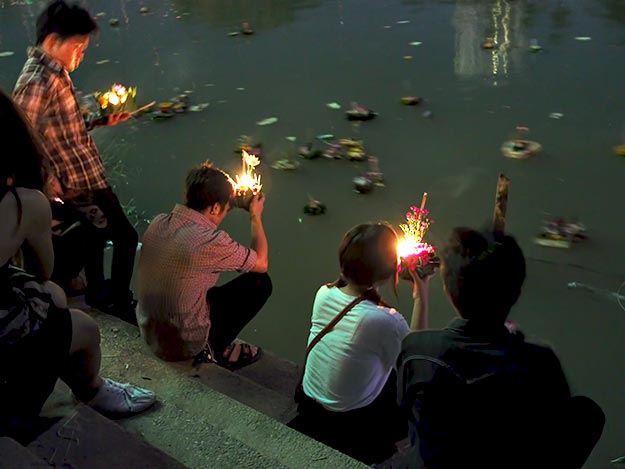
Some claim it can be traced to a footprint that Buddha is said to have left on the beach of the Narmada River in India. Krathongs were believed to atone for the sin of riverboats passing over his footprint throughout the year. In rural Thai villages, elders launch krathongs to ask forgiveness from the river goddess, Phra Mae Kongkha, for having polluted the waterways. Interestingly, the word Khongkha in Thai translates to “Ganga” in Hindu, the word for India’s Holy Ganges River.

Perhaps the most oft repeated explanation is the legend of Nang Nophamas, the favored consort of King Ramkhamhaeng of Sukhothai, the first capital of Thailand. The King was a Buddhist, but his favorite consort was Brahman (Hindu). When the time came to honor the Brahman water goddess, Nophamas built the first banana leaf krathong in the form of lotus blossom and released it on the river. The common folk, amazed by her beautiful creation, began making their own krathong. Being a wise ruler and wiser husband, the king decreed that this would also be a Buddhist celebration and dedicated the krathongs to Lord Buddha.
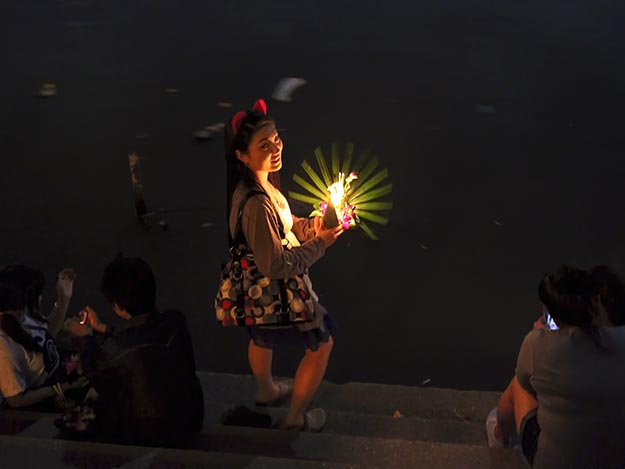
Seven hundred years later, the four-day Loy Krathong Festival is still going strong. It is held during the full moon in the 12th month of the Thai lunar calendar (usually in November), and the epicenter of the celebration is always in Chiang Mai. As usual, this year’s events were kicked off with an opening ceremony in the center of the Old City. Hundreds of local women dressed in traditional silk sarongs and jackets sat patiently in the street while a local monk blessed the proceedings.

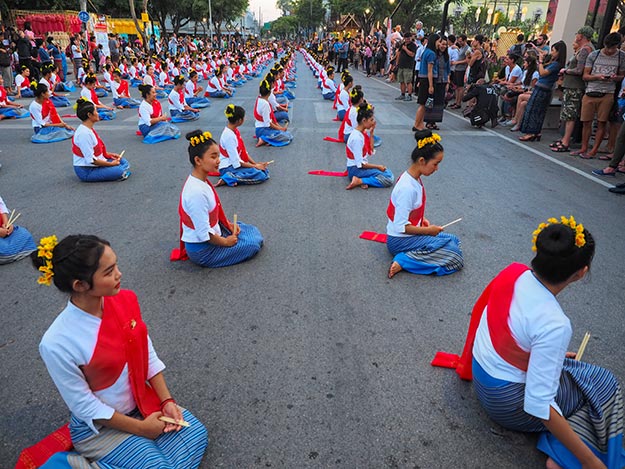
His dedication complete, the women rose and began to dance in slow, mincing steps. Holding a lighted candle in each hand, they turned as one toward each of the eight cardinal points, paying homage to the divinities that protect the Earth. From my curbside spot I stood on tiptoes and looked up and down the street. The dancers stretched as far as I could see, a human rainbow of silk in a sea of glittering candles, bobbing up and down, swaying side-to-side.

Transfixed, I focused on a women of my age, dancing directly in front of me. She moved so serenely and effortlessly, seemingly unaware of her surroundings. I couldn’t take my eyes off of her. When the dance concluded I smiled at her and said, “Su-WHY!” Beautiful. She smiled back. “It is my therapy,” she answered in English. I understood completely.
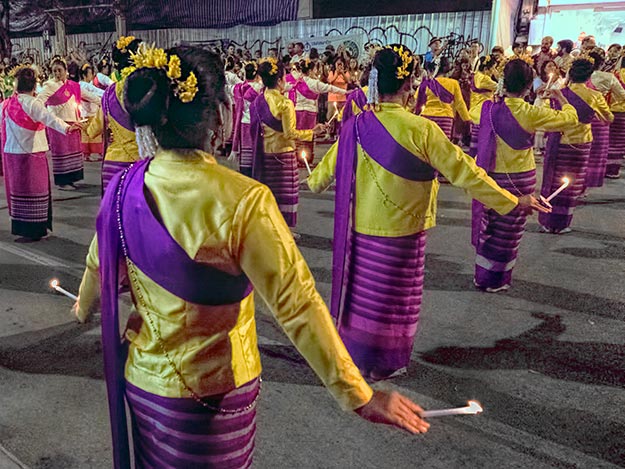
Following the opening ceremonies, spectators began making their way down to the Mae Ping. Those who had not made a krathong purchased one from the myriad shops set up alongside the river. The design and construction of krathongs still follows ancient traditions. The base is usually formed from a slice of a banana tree trunk, although slices of bread or even styrofoam are sometimes used. That is topped with banana leaves that are intricately folded into the form of a lotus flower.
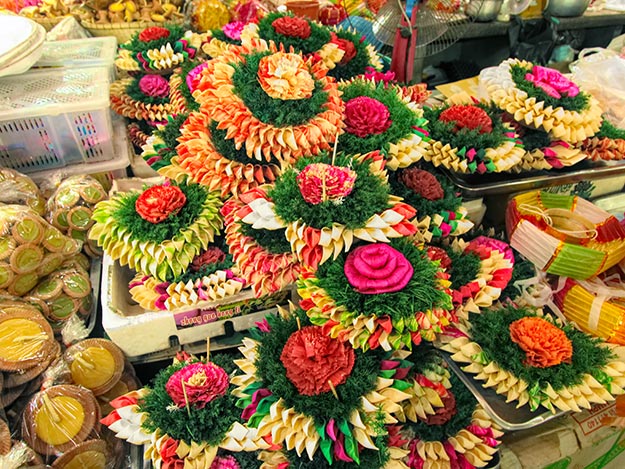
Fresh flowers and a candle are placed in the center of the lotus cup, and three incense sticks are added to honor the three jewels: the Buddha, the Dharma (teachings of the Buddha), and the Sangha (the community of monks, nuns, novices, and laity). A more modern practice is to also include a few small denomination coins as an offering to the river spirits. Many Thais also include a bit of hair and fingernail clippings as a symbol of letting go of past transgressions and negative thoughts.

While everyone knows the religious legends associated with the festival, today most Thais believe that krathongs will carry away their sins and bad luck and bring them happiness in the coming year. And as they say, it couldn’t hurt. So I chose a krathong (making sure it did NOT have a non-biodegradable styrofoam base), carried it to the riverbank, and released it. After all, who am I to argue with 700 years of history and tradition?
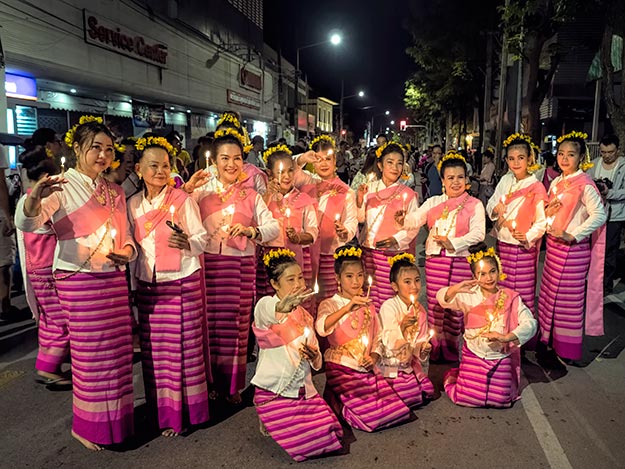
If you enjoyed this story, you may be interested in my article about the Yee Peng Festival in Chiang Mai, which runs concurrently with the Loy Krathong Festival.

It’s been a year now since I came back from my long stay in Thailand and I still miss it. This festival and dance shows are stunning. Songkran is also an interesting experience if you ever have an opportunity to see it 🙂
Hi Dorota: Yep, I live here, so I’ve definitely been in the thick of Songkran. It’s a time for wearing old clothes (because you’re going to get soaked), and carrying your mobile in plastic bags 🙂
I wasn’t aware of the Loy Krathong Festival until I read your article. It looks so interesting and -wow!- so colorful! I still haven’t planned a visit to Thailand but I’m definitely more intrigued now. Thanks for sharing and a happy 2019 🙂
Happy 2019 to you too George, and thanks so much for your comment.
Gorgeous pictures Barbara. I spent many days gazing at this river when we used to stay by it, at Chiang Mai Riverside Condos. Hopefully we get to be in CM during this festival.
I hope so too Ryan – I’d really love to see you again!